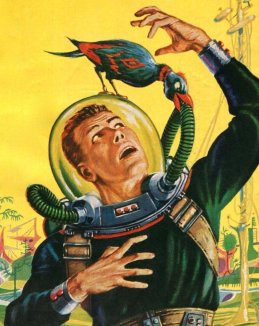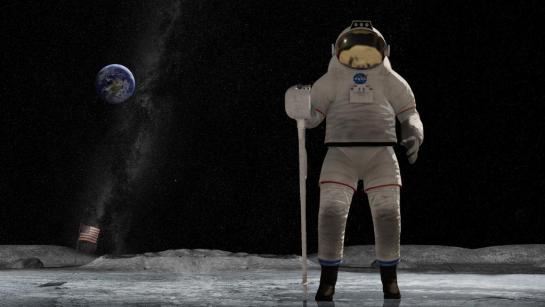Spacesuits are functional items, built largely identically to each other, adhering to engineering specifications rather than individualized fashion. A resulting problem is that it might be difficult to distinguish between multiple, similarly-sized individuals wearing the same suits. This visual identification problem might be small in routine situations:
- (Inside the vehicle:) Which of these suits it mine?
- What’s the body language of the person currently speaking on comms?
- (With a large team performing a manual hull inspection:) Who is that approaching me? If it’s the Fleet Admiral I may need to stand and salute.
But it could quickly become vital in others:
- Who’s body is that floating away into space?
- Ensign Smith just announced they have a tachyon bomb in their suit. Which one is Ensign Smith?
- Who is this on the security footage cutting the phlebotinum conduit?
There a number of ways sci-fi has solved this problem.
Name tags
Especially in harder sci-fi shows, spacewalkers have a name tag on the suit. The type is often so small that you’d need to be quite close to read it, and weird convention has these tags in all-capital letters even though lower-case is easier to read, especially in low light and especially at a distance. And the tags are placed near the breast of the suit, so the spacewalker would also have to be facing you. So all told, not that useful on actual extravehicular missions.
Faces
Screen sci-fi usually gets around the identification problem by having transparent visors. In B-movies and sci-fi illustrations from the 1950s and 60s, the fishbowl helmet was popular, but of course offering little protection, little light control, and weird audio effects for the wearer. Blockbuster movies were mostly a little smarter about it.

c/o Diane Doniol-Valcroze
Seeing faces allows other spacewalkers/characters (and the audience) to recognize individuals and, to a lesser extent, how their faces synch with their voice and movement. People are generally good at reading the kinesics of faces, so there’s a solid rationale for trying to make transparency work.
Face + illumination
As of the 1970s, filmmakers began to add interior lights that illuminate the wearer’s face. This makes lighting them easier, but face illumination is problematic in the real world. If you illuminate the whole face including the eyes, then the spacewalker is partially blinded. If you illuminate the whole face but not the eyes, they get that whole eyeless-skull effect that makes them look super spooky. (Played to effect by director Scott and cinematographer Vanlint in Alien, see below.)
Identification aside: Transparent visors are problematic for other reasons. Permanently-and-perfectly transparent glass risks the spacewalker getting damage from infrared lights or blinded from sudden exposure to nearby suns, or explosions, or engine exhaust ports, etc. etc. This is why NASA helmets have the gold layer on their visors: it lets in visible light and blocks nearly all infrared.

Image Credit: NASA (cropped)
Only in 2001 does the survey show a visor with a manually-adjustable translucency. You can imagine that this would be more safe if it was automatic. Electronics can respond much faster than people, changing in near-real time to keep sudden environmental illumination within safe human ranges.
You can even imagine smarter visors that selectively dim regions (rather than the whole thing), to just block out, say, the nearby solar flare, or to expose the faces of two spacewalkers talking to each other, but I don’t see this in the survey. It’s mostly just transparency and hope nobody realizes these eyeballs would get fried.
So, though seeing faces helps solve some of the identification problem, transparent enclosures don’t make a lot of sense from a real-world perspective. But it’s immediate and emotionally rewarding for audiences to see the actors’ faces, and with easy cinegenic workarounds, I suspect identification-by-face is here in sci-fi for the long haul, at least until a majority of audiences experience spacewalking for themselves and realize how much of an artistic convention this is.
Color
Other shows have taken the notion of identification further, and distinguished wearers by color. Mission to Mars, Interstellar, and Stowaway did this similar to the way NASA does it, i.e. with colored bands around upper arms and sometimes thighs.
Destination Moon, 2001: A Space Odyssey, and Star Trek (2009) provided spacesuits in entirely different colors. (Star Trek even equipped the suits with matching parachutes, though for the pedantic, let’s acknowledge these were “just” upper-atmosphere suits.)The full-suit color certainly makes identification easier at a distance, but seems like it would be more expensive and introduce albedo differences between the suits.
One other note: if the visor is opaque and characters are only relying on the color for identification, it becomes easier for someone to don the suit and “impersonate” its usual wearer to commit spacewalking crimes. Oh. My. Zod. The phlebotinum conduit!
According to the Colour Blind Awareness organisation, blindness (color vision deficiency) affects approximately 1 in 12 men and 1 in 200 women in the world, so is not without its problems, and might need to be combined with bold patterns to be more broadly accessible.
What we don’t see
Heraldry
Blog from another Mog Project Rho tells us that books have suggested heraldry as space suit identifiers. And while it could be a device placed on the chest like medieval suits of armor, it might be made larger, higher contrast, and wraparound to be distinguishable from farther away.
Directional audio
Indirect, but if the soundscape inside the helmet can be directional (like a personal Surround Sound) then different voices can come from the direction of the speaker, helping uniquely identify them by position. If there are two close together and none others to be concerned about, their directions can be shifted to increase their spatial distinction. When no one is speaking leitmotifs assigned to each other spacewalker, with volumes corresponding to distance, could help maintain field awareness.
HUD Map
Gamers might expect a map in a HUD that showed the environment and icons for people with labeled names.
Search
If the spacewalker can have private audio, shouldn’t she just be able to ask, “Who’s that?” while looking at someone and hear a reply or see a label on a HUD? It would also be very useful if I’ve spacewalker could ask for lights to be illuminated on the exterior of another’s suit. Very useful if that other someone is floating unconscious in space.
Mediated Reality Identification
Lastly I didn’t see any mediated reality assists: augmented or virtual reality. Imagine a context-aware and person-aware heads-up display that labeled the people in sight. Technological identification could also incorporate in-suit biometrics to avoid the spacesuit-as-disguise problem. The helmet camera confirms that the face inside Sargeant McBeef’s suit is actually that dastardly Dr. Antagonist!
We could also imagine that the helmet could be completely enclosed, but be virtually transparent. Retinal projectors would provide the appearance of other spacewalkers—from live cameras in their helmets—as if they had fishbowl helmets. Other information would fit the HUD depending on the context, but such labels would enable identification in a way that is more technology-forward and cinegenic. But, of course, all mediated solutions introduce layers of technology that also introduces more potential points of failure, so not a simple choice for the real-world.

So, as you can read, there’s no slam-dunk solution that meets both cinegenic and real-world needs. Given that so much of our emotional experience is informed by the faces of actors, I expect to see transparent visors in sci-fi for the foreseeable future. But it’s ripe for innovation.





































































































































